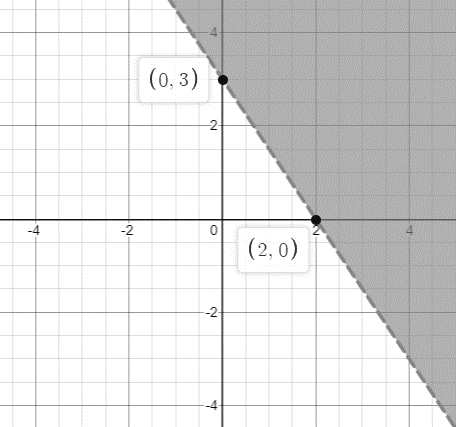
How do you graph \[3x + 2y > 6\] ?
Answer
541.8k+ views
Hint: we need to find the method to obtain the graph of \[3x + 2y > 6\] to obtain its graph first find the value of the x intercept by substituting the value of x=0 and then find the value of the y intercept find taking the value of y equal to 0. Then, check whether the origin lies in the plane of the line and then determine the part of the graph that lies within the region of the inequalities.
Complete Step By Step solution:
In this question we have given the inequality as \[3x + 2y > 6\] and we need to draw the graph of the given inequality.
The first step is to find the intercepts.
The x intercept is calculated as,
\[
3\left( 0 \right) + 2y = 6 \\
0 + 2y = 6 \\
2y = 6 \\
\Rightarrow y = \dfrac{6}{2} \\
\Rightarrow y = 3 \\
\]
The y intercept is calculated as,
\[
3x + 2\left( 0 \right) = 6 \\
3x = 6 \\
\Rightarrow x = \dfrac{6}{3} \\
\Rightarrow x = 2 \\
\]
The points to be plotted on the graph are \[\left( {0,3} \right)\] and\[\left( {2,0} \right)\].
The next step is to join these two points on the graph.
Now to check if the origin lies in the plane of the solution for\[3x + 2y = 6\]. Substitute the origin coordinates in the equation as,
\[
3\left( 0 \right) + 2\left( 0 \right) > 6 \\
0 + 0 > 6 \\
0 > 6 \\
\]
The above statement is false as the value \[0\] is less than \[6\] so the origin does not lie in the plane of\[3x + 2y > 6\].
To make the graph for\[3x + 2y > 6\], shade all the points to the right of the line\[3x + 2y = 6\]. This suggests that all the points that lie to the right for the line of \[3x + 2y = 6\] are the solution of the given inequality.
Now, we will consider the graph of the given inequality equation as,

Note:
As we know that the linear inequalities are the expression in which two values are compared by the use of inequality symbols like \[ < , > , \leqslant \] and \[ \geqslant \]. The values can be numeric, algebraic or both the values.
Complete Step By Step solution:
In this question we have given the inequality as \[3x + 2y > 6\] and we need to draw the graph of the given inequality.
The first step is to find the intercepts.
The x intercept is calculated as,
\[
3\left( 0 \right) + 2y = 6 \\
0 + 2y = 6 \\
2y = 6 \\
\Rightarrow y = \dfrac{6}{2} \\
\Rightarrow y = 3 \\
\]
The y intercept is calculated as,
\[
3x + 2\left( 0 \right) = 6 \\
3x = 6 \\
\Rightarrow x = \dfrac{6}{3} \\
\Rightarrow x = 2 \\
\]
The points to be plotted on the graph are \[\left( {0,3} \right)\] and\[\left( {2,0} \right)\].
The next step is to join these two points on the graph.
Now to check if the origin lies in the plane of the solution for\[3x + 2y = 6\]. Substitute the origin coordinates in the equation as,
\[
3\left( 0 \right) + 2\left( 0 \right) > 6 \\
0 + 0 > 6 \\
0 > 6 \\
\]
The above statement is false as the value \[0\] is less than \[6\] so the origin does not lie in the plane of\[3x + 2y > 6\].
To make the graph for\[3x + 2y > 6\], shade all the points to the right of the line\[3x + 2y = 6\]. This suggests that all the points that lie to the right for the line of \[3x + 2y = 6\] are the solution of the given inequality.
Now, we will consider the graph of the given inequality equation as,

Note:
As we know that the linear inequalities are the expression in which two values are compared by the use of inequality symbols like \[ < , > , \leqslant \] and \[ \geqslant \]. The values can be numeric, algebraic or both the values.
Recently Updated Pages
Two men on either side of the cliff 90m height observe class 10 maths CBSE

What happens to glucose which enters nephron along class 10 biology CBSE

Cutting of the Chinese melon means A The business and class 10 social science CBSE

Write a dialogue with at least ten utterances between class 10 english CBSE

Show an aquatic food chain using the following organisms class 10 biology CBSE

A circle is inscribed in an equilateral triangle and class 10 maths CBSE

Trending doubts
Why is there a time difference of about 5 hours between class 10 social science CBSE

Write a letter to the principal requesting him to grant class 10 english CBSE

What is the median of the first 10 natural numbers class 10 maths CBSE

The Equation xxx + 2 is Satisfied when x is Equal to Class 10 Maths

Which of the following does not have a fundamental class 10 physics CBSE

State and prove converse of BPT Basic Proportionality class 10 maths CBSE




